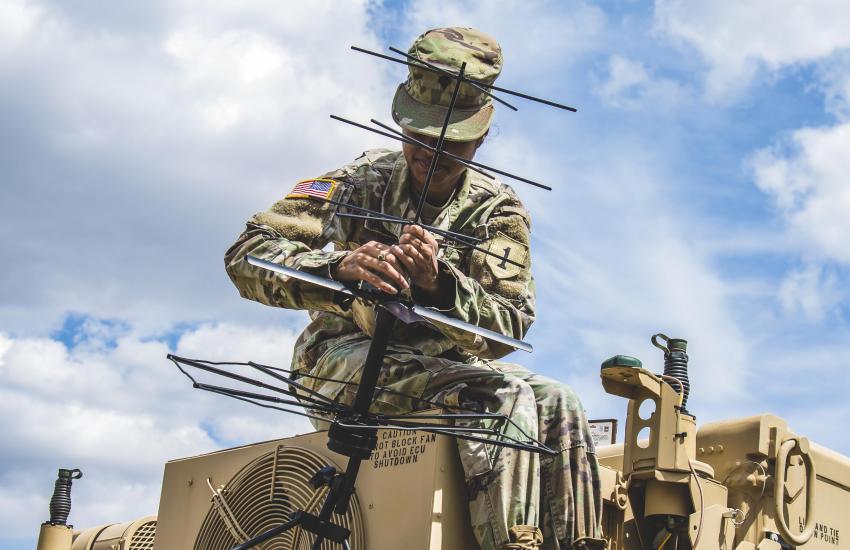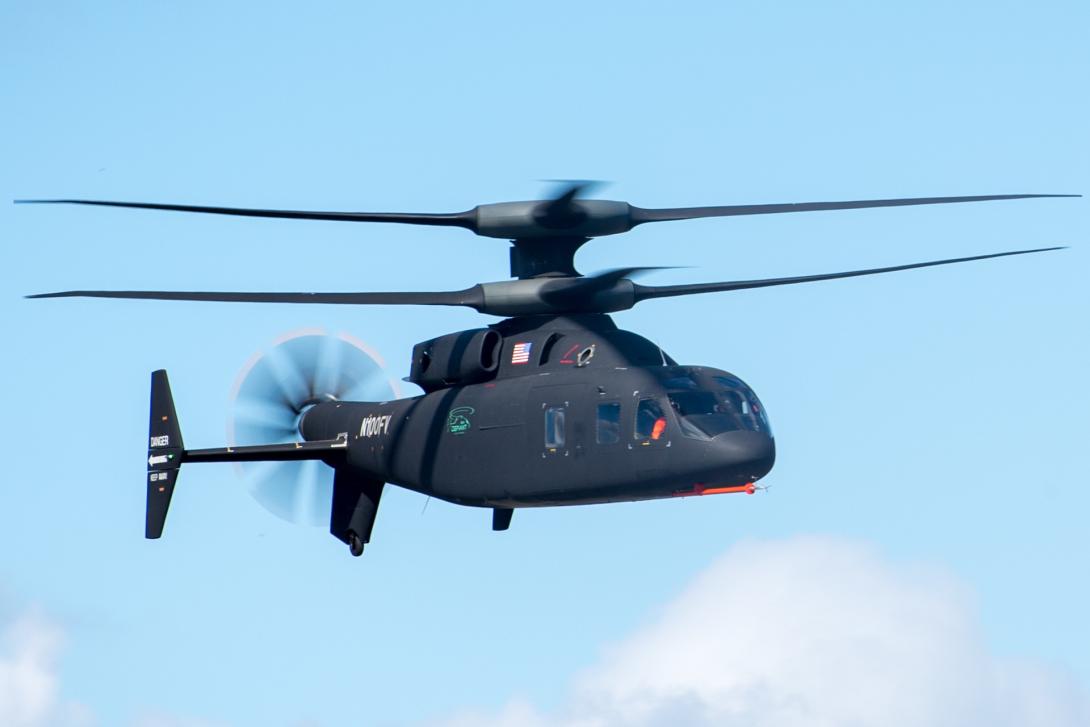Army Aims to Fully Push Electromagnetic Spectrum
The U.S. Army of the future may move away from the traditional radio frequencies toward little-used spectrum in part by using card-based radios, liquid metal antennas and laser communications.
Today’s Army relies largely on L-, S- and C-band frequencies. The first are ultra-high frequencies in the 1 and 2 gigahertz range. The second is part of the microwave band between 2 and 4 gigahertz, and the third also is in the microwave range and includes frequencies between 4 and 8 gigahertz.
Those traditional frequencies are becoming more crowded with the constant push for more wireless devices and the move toward next-generation cellular capabilities and smart cities. In fact, the military has been forced to sell part of its traditional spectrum for commercial use.
“We have traditional frequencies that not just the United States, but a lot of our allied partners operate in. That’s perfectly fine,” says James Tucker Swindell, chief of the Radio Frequency Communications Division within the Army’s Command, Control, Communications, Computers, Cyber, Intelligence, Surveillance and Reconnaissance (C5ISR) Center. “But everyone also knows that everyone else operates in those frequencies, so from a threat perspective, we always have to keep in mind what’s out there and how we’re trying to defeat it.”
For future warfighters, researchers intend to push the outer limits, so to speak, of spectrum. “We’re going to really try to push the electromagnetic spectrum to its fullest extent,” Swindell says. “We’re not going after the lowest hanging fruit. We are going after what we believe is achievable in the science and technology midterm.”
Transforming communications for the future force may begin with a change in the dialogue. “Something I plan on doing is changing the name of the vision to full-spectrum communications because we have to get away from traditional radio frequencies. If you look across the electromagnetic spectrum, the entire electromagnetic spectrum, there are a lot of frequencies out there that we simply haven’t touched,” Swindell adds.
But, of course, technology also will have to change. “Just to create a new radio that operates in the same frequency bands we’ve always operated in poses a couple of different problems and one of those is simply spectrum availability. Everybody can’t turn on an L-band radio at the same time and expect to communicate properly,” Swindell states.
The largely untouched spectrum bands include Q, V, W and higher. Those frequencies offer multiple benefits: they do not currently carry as much communications traffic, and they provide a lot of communications throughput. The benefits, however, come with a sacrifice of range, Swindell notes. “When I say a sacrifice of range, it really is a power problem. You can certainly get the same amount of range. It’s just a matter of how much power you might have to put through it.”
Swindell touts the benefits of CMOSS-capable radios. CMOSS is an acronym within an acronym that stands for C5ISR/Electronic Warfare Modular Open Suite of Standards, and it is a modular architecture that converges multiple warfighting capabilities including mission command, movement, maneuver and fires into one system. Capabilities are fielded as cards and can be swapped as necessary.
He says he tells every vendor who will listen that he is no longer investing science and technology dollars in “bespoke” radios built by one vendor that will remain the primary radio system in the Army for 20 years. Such a radio “becomes a brick” when attacked by a peer or near-peer adversary, at least until the vendor can upgrade the firmware or find another solution to overcome the threat.
“I want to employ a card-based radio system. We will use the radio, and if that radio is compromised, we can pop the card out that has that waveform on it—kind of like the old Nintendos—and you put the new card in. Now you have the same handset that the soldier can use, but it’s a different waveform. It can be from a different vendor.”
Swindell wants the CMOSS standard incorporated across science and technology projects. “It will change not just radio frequency from a radio communications perspective but how we operate with radar, electronic warfare, signal intelligence, cyber,” he says.
Advanced antenna technologies also are likely to make a difference for future warfighters. One way to maximize communications power and range is to focus energy in one direction with directional antennas rather than the omnidirectional antennas most commonly used in the Army today. As the name suggests, omnidirectional antennas emit signals in all directions and are more easily detected. That probability of detection is a greater concern against a peer or near-peer competitor than it was in Afghanistan.
“With an omnidirectional antenna, face the fact that you are spreading your signal in every direction. That means the enemy does get a bite of it. We certainly have a lot of great capability in waveform development that’s ongoing here at the center, but the bottom line is the enemy gets a bite,” Swindell asserts. “On the flip side, if I’m using a directional antenna, I might not need as much power because I’m able to focus all of the energy in one direction versus omni,” Swindell says.
He illustrates the difference between omni and directional antennas with a metaphor, comparing an omni antenna to a pond pouring into a lake with the water spreading in every direction. “With a directional antenna in effect, I’m skipping a rock off that lake. I’m pushing everything in one direction, so for the same amount of force, in this case power, I get the range and direction but not omnidirection.”

We’re going to really try to push the electromagnetic spectrum to its fullest extent.
Directional and omnidirectional antennas offer other pros and cons as well. Omnidirectional systems, for example, work better in wooded areas. They do not penetrate foliage but instead offer what Swindell describes as a “peek through” capability. “Where you get a lot of value out of those directional antennas and wideband antennas are in the higher frequencies, but you do lose a bit of the foliage peek-through. You’ll be able to get a lot more signal through, though, so there are some advantages on that end too. We’re really trying to balance those from a science and technology perspective.”
Future warfighters also could benefit from free-space optics, a form of laser communication. The lasers use line-of-sight optical bandwidth to transmit voice, video and data. “The only way you can capture my signal is to get between me and the person I’m talking to and to know the exact frequency and waveform, in this case, that I’m utilizing,” Swindell says.
The challenge comes in the form of size, weight and power, commonly referred to as SWaP. “There are free space optic systems that exist today. However, they’re kind of bulky, for the most part. There are some smaller ones, but they’ve got some work when it comes to a tactical application,” he explains. “If I bring in the most beautiful thing in the world, and it works in an amazing way, and everything’s wonderful, but it weighs 500 pounds and is as big as a container truck, then it’s not going to be tactically relevant.”
The C5ISR Center also is researching liquid metal and conformal antennas that can take a variety of shapes to enhance Army mobility. Swindell cites the planned Future Vertical Lift family of Army helicopters as an example. “You can’t just hang every antenna you want to off of the skin of an aircraft. It’s going to produce too much drag. You can’t fly at however many knots they’re trying to push those birds if you’ve got antennas sticking out of the right and left sides of the vehicle,” he says. “I have to make sure that the systems we develop do not just fit the vehicle, but they fit the need.”

I have to make sure that the systems we develop do not just fit the vehicle, but they fit the need.






Comments